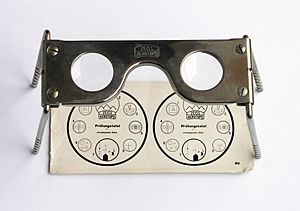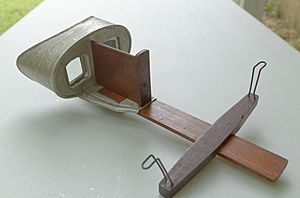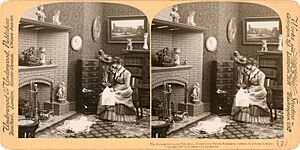Stereoscope facts for kids
A stereoscope is a cool device that lets you see flat pictures in 3D! It works by showing your left eye one picture and your right eye a slightly different picture. These two pictures are called a stereoscopic pair. When your brain puts them together, it creates the illusion of a single, deep, three-dimensional image.
Think of it like this: your eyes are a few inches apart. Because of this, each eye sees the world from a slightly different angle. Your brain uses these tiny differences to figure out how far away things are, giving you depth perception. A stereoscope tricks your brain into seeing depth by showing each eye a picture taken from a slightly different viewpoint, just like your eyes would naturally see.
Most stereoscopes have special lenses. These lenses make the pictures look bigger and farther away. They also help shift the pictures so your eyes can easily combine them into one 3D view. There's usually a divider in the middle. This divider stops each eye from seeing the picture meant for the other eye.
Even though you can sometimes see 3D without a stereoscope, it can be hard on your eyes. A stereoscope makes it much easier and more comfortable. Devices like the View-Master are types of stereoscopes. However, the word "stereoscope" often makes people think of the older viewers used for stereo cards from the 1850s to the 1930s. These cards were a popular way to have fun at home.
It's important to know that some 3D glasses, like those used in cinemas, are not stereoscopes. Those glasses work differently. They combine two images that are already on top of each other, instead of showing your eyes two separate pictures.
How Stereoscopes Create 3D Images
A simple stereoscope can only use small pictures. But more advanced ones use parts that act like tiny periscopes. This lets them use bigger pictures. Bigger pictures mean you can see more details and a wider view. The main idea is always the same: two photos of the same thing are shown at the same time, one to each eye. These photos are taken from slightly different angles.
This setup copies how your own eyes work. Because your eyes are a few inches apart, each eye sees an object from a slightly different angle. This is what gives us natural depth perception. A stereoscope uses separate lenses for each picture. By showing each eye a photo taken a few inches apart and focused on the same spot, it perfectly recreates the natural feeling of seeing things in three dimensions.
There were even stereoscopes that showed moving pictures! These had a large spinning drum. Inside the drum were many stereo cards that made a short movie. You would crank a handle to make the cards flip into view. These coin-operated machines were popular in arcades in the late 1800s and early 1900s. You can still find and use them in some museums today!
Why Stereoscopes Are Helpful
Stereoscopes offer several cool benefits:
- Less Eye Strain: They use special magnifying lenses. These lenses make the pictures seem far away, almost like they're at infinity. This helps your eyes focus easily and reduces strain.
- Bigger Pictures: The lenses also make the pictures look larger. This means you get a wider view and can see all the tiny details in the photo.
- No Distractions: The viewer usually has a divider. This divider keeps each eye focused only on its own picture, so you don't get distracted.
A stereo transparency viewer, like the View-Master, works in a similar way and offers these same advantages.
One small problem with old stereo cards or slides is that they can get worn out or scratched. If one picture gets damaged more than the other, it can make the 3D effect less clear. This might even cause eye strain or headaches.
See also
 In Spanish: Estereoscopio para niños
In Spanish: Estereoscopio para niños




